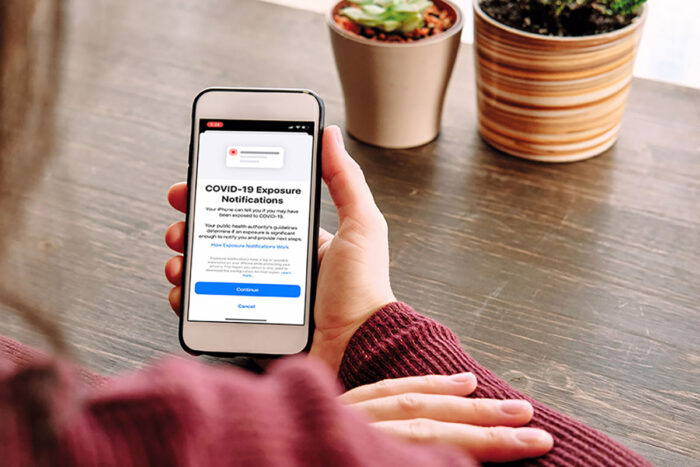COVID-19 Exposure Notifications system launches for university community
Smartphone system complements traditional contact tracing
 Getty Images/Mike Worful
Getty Images/Mike WorfulFaculty, staff and students at Washington University in St. Louis will now be able to use a COVID-19 exposure notification system. Launched in collaboration with Google and Apple, the system runs on iOS and Android devices.
Washington University in St. Louis is launching a smartphone system that allows Washington University faculty, staff and students to use COVID-19 Exposure Notifications. It is being launched with approval from the state of Missouri and the Missouri Department of Health and Senior Services, and uses the exposure notifications system provided by Google and Apple.
The university is piloting the system, called MO/Notify, which can alert users when they have been near another user who has tested positive for the virus that causes COVID-19. The goal of the pilot program is to investigate how effective the system can be in the university’s arsenal against COVID-19. After the pilot period, Washington University will look to lead efforts to potentially expand the system. Exposure Notifications is already in use in 25 states, including California, Colorado and Washington.
“It’s a way of getting alerts of possible exposures to people very quickly so they can take appropriate action,” said Philip R.O. Payne, PhD, director of the university’s Institute for Informatics and associate dean for health information and data science. “Quick notification can have a huge impact on the dynamics of a pandemic, especially as we continue to re-open our university and need to keep tabs on new variants and their impact on our campus community.
“Even with vaccination, this virus is going to be with us for a while,” Payne added. “As case numbers fluctuate, there will be pockets of the infection that we will need to identify and monitor — especially with the more transmissible variants — so the need for exposure notifications is not going to go away anytime soon.”
The Institute for Informatics has led the design and deployment of this COVID-19 notification system for the university community, working with Google and Apple to make it available to students, faculty and staff and integrate it into the university’s student health and occupational health services.
Payne, also chief data scientist for the School of Medicine, described the new system as an additional part of a layered approach to protecting the university community, including faculty, staff and students on the Danforth and Medical campuses.
“There’s no single solution to stopping viral transmission,” he said. “We are now adding this exposure notifications system to our current set of tools that we can harness against the spread of COVID-19, including testing, traditional contact tracing, symptom monitoring, masking and vaccination to keep our campus communities safe.”
Running on iOS and Android devices, the system uses a smartphone’s Bluetooth to exchange randomly generated codes with nearby smartphones also running the system. When two phones are close to one another, the phones record each other’s random codes and store them for 14 days on the device. The codes also change periodically to further protect privacy. Users must explicitly enable Exposure Notifications for the system to be running on the device.
When a person who uses the system tests positive for COVID-19, the university’s occupational health or student health office will verify the positive test to serve as a safeguard against false alarms. Users can choose to share their positive tests in the system to help notify other users who were nearby and have also enabled the Exposure Notifications system of possible COVID-19 exposure.
“We are pleased to be offering this system to help safeguard the health of our faculty, staff and students,” said Eva Aagaard, MD, vice chancellor for medical education and the Carol B. and Jerome T. Loeb Professor of Medical Education. “This technology will enable the university community to continue its work and reduce the spread of COVID-19, especially since the virus is expected to continue to evolve.” Aagaard also is the senior associate dean for education and interim senior administrator for occupational health.
Payne noted that the new system supplements traditional contact tracing. A traditional contact tracer talks with the person who has tested positive, gathers information about close contacts and notifies those contacts by phone, email or text of an exposure. In contrast, the smartphone system can provide notifications to people who do not know one another.
“Traditional contact tracing remains a vital tool in our efforts to stop the spread of COVID-19, but it can take days or longer to identify a person’s close contacts and notify them individually,” said Payne, also the Janet and Bernard Becker Professor. “It also relies on the memory of the person who has tested positive to say who they interacted with over the past two weeks. The notification tool can speed this process up considerably.”
“We’re excited to be providing this type of technology to our faculty, staff and students,” Payne said. “It is a system that protects privacy as it helps the university to continue its mission and keep students, faculty and staff healthy at the same time. We look forward to implementing it on campus and the opportunity to help expand the new system to other organizations across the state.”
On Android, you can find the app on Google Play. If you have an iPhone, opt-in to Exposure Notifications in Settings > Exposure Notifications on your device.







